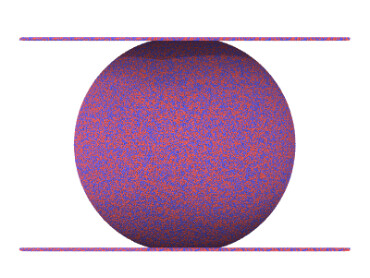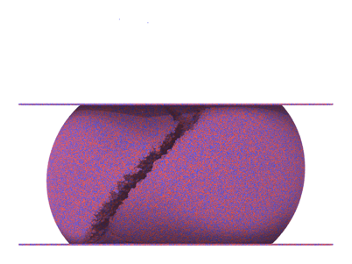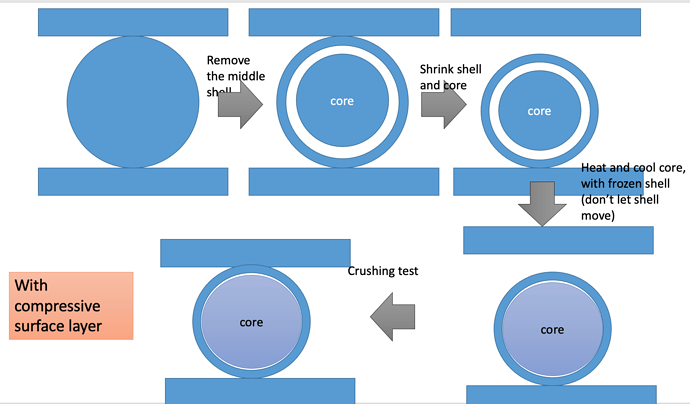Dear All,
I have a sphere of glass. It’s very brittle with a bump lj potential. I am trying to shot peen it i.e. apply compressive stress on its surface and then crush it afterwards. I am having trouble with 1st part - applying compressive stress. I tried the deform scale 0.8 in x y and z in Lammps and the simulation gets very very unstable. Anybody here knows how to apply compressive stress is on the surface of the sphere in Lammps I would really appreciate your help.
Thank you
Joe
RPI
Physics Phd Student
It is very difficult to provide any kind of meaningful advice on such a terse description without a schematic of what you are trying to achieve or a small demonstration input.
Due to the lack of detail I have to guess what you are actually doing. Perhaps fix wall/region can be used for your system, but I am not even convinced that what you are describing is a model with meaningful physics.
Dear Dr. Axel,
Thank you very much for your reply and I apologize for brevity I was trying to not burden readers on first encounter.
Here it is: I model a block of binary glass - 2 atom types / m1 = 2m2 - this glass is now at very low temperature(0.016 reduced lj units ~28 K) and solid. From the glass I carve out - using geometry -a sphere in the middle and an upper and lower plates all made up of those very same atoms. Model attached. I already know this glass is brittle by demonstrating this through compression tests at different sphere radii (by replicating) allowing the top plate to act as an indenter moving down at constant velocity and crushing the sphere. all that is done. So now what I’m trying to do is apply compressive stress on the surface of the sphere before the crushing test to see if the brittleness of the glass changes after - it’s shot peening - and if the same crushing test would yield brittle to ductile transition at a some and/or different radius. For that I create an empty shell as shown below. I then deform the entire shell and core inwards only a few percent:
fix 2 gsphereplus deform 10 x scale 0.97 y scale 0.97 z scale 0.97
Then plan is to heat and cool the core while holding the shell fixed - through fix force and velocity - relax and then apply crushing test again.
Thank you.


Joe
RPI
Physics Phd Student
That should not be a concern when using written text. Unlike when talking to people, it is easy to stop if one is not interested or skip over irrelevant parts if too much information is presented. But for too little information there is no easy way to get it. So you are actually creating the burden of having to ask for more details. ![]()
Using fix wall/region should be applicable to your case. The only concern would be that you are trying to model a macroscopic process on an atomic scale. So results will have to be interpreted rather carefully.
Below is a minimal example demonstrating how to create a spherical confinement and how to change its size either statically or continuously during a run.
boundary f f f
units lj
lattice fcc 0.85
variable radius equal 7.5
region box block -10.0 10.0 -10.0 10.0 -10.0 10.0 units lattice
region sphere sphere 0.0 0.0 0.0 v_radius units lattice side in
create_box 1 box
create_atoms 1 region sphere
mass 1 1.0
pair_style lj/cut 2.5
pair_coeff 1 1 1.0 1.0
velocity all create 2.0 253463 loop geom
# set larger radius to account for 2.5 sigma distance between start and max of wall force
variable radius equal 10.0
fix 1 all nve
fix 2 all wall/region sphere harmonic 10.0 0.0 2.5
dump 1 all atom 20 fixed.lammpstrj
thermo 100
run 1000 post no
undump 1
reset_timestep 0
# now apply linear squeeze during run
variable radius equal ramp(10.0,8.0)
dump 1 all atom 20 shrink.lammpstrj
run 1000 post no
undump 1
Thank you very much Dr. Axel for all this help… Apologies Sure from now on I will provide enough detail to my inquiries to not leave helpers wondering.
I will think through this and apply it to my case…
